HappyFresh Malaysia’s own warehouses are its latest strategy toward a path of profitability
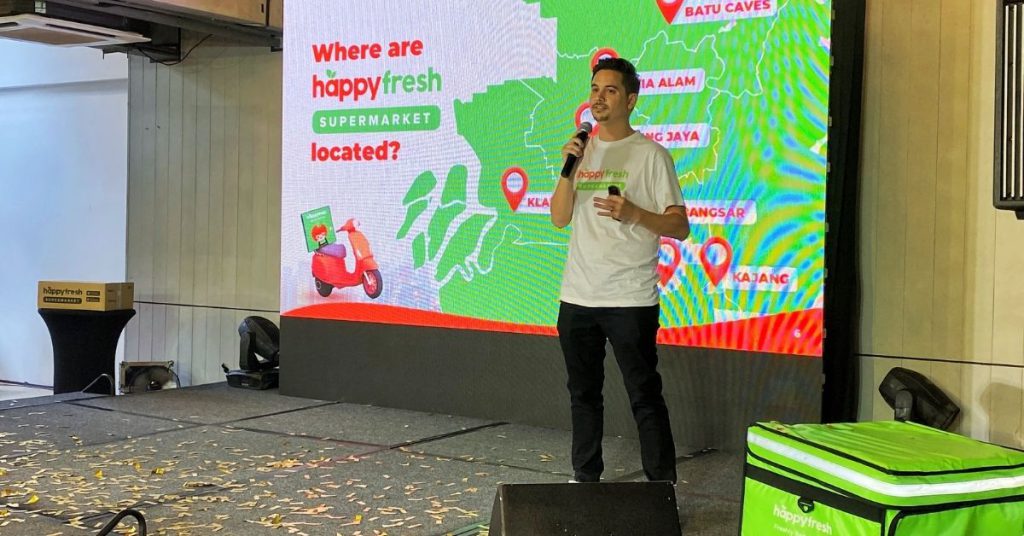
Admittedly, I’ve yet to see the value of online grocery apps, since I still prefer to see and feel products in person before purchasing.
But surely, with the existence of GrabMart, pandamart, MyGroser, and more, there has to be some merit to the concept.
HappyFresh is another online grocery player that’s been delivering fresh groceries in Malaysia since 2015, and it recently officially introduced HappyFresh Supermarket, a line of cloud warehouses.
Cloud warehouses are inventory stores that are purpose-built only for deliveries, not walk-ins.
In an interview with Vulcan Post at the introductory event, Chief Growth Officer, Johan Antlov, shared how this was HappyFresh Malaysia’s latest strategy to cement its position in the industry.
The path to profitability
First, he explained their vision:
For us, it was really about building our own paths and how we envision a supermarket to be. We wanted to have end-to-end control over the whole experience, which means from the products that are shown to the customers, to the prices that we have decided [on], to the fulfilment experience.
Johan Antlov, Chief Growth Officer
Hence, their first move toward this was to invest in their own warehouses, since Johan and his team knew that that was necessary to really build [customer] trust and reliability.
They looked into the economic landscape and tried to figure out what users wanted when it came to not just online grocery shopping, but grocery shopping in general.
“And it’s been clear over the past couple of years that people want to make a saving but they don’t want to have the cheapest product all the time,” Johan said.

Clearly, HappyFresh Supermarket is a very different model from what HappyFresh has done in the past—that is, working with retailers (which they will continue to do).
With their own warehouses, they will do direct sourcing with different brands, and have different cost structures in place.
“That means our margin structure is very different, so we can offer these low prices now, along with free delivery. And when we do the economics of this in the long term, this has a clear path to profitability,” Johan added.
“Finding the balance between what’s interesting for the users but makes sense for the business is something that looks very good on an Excel sheet, and we’ll continue to tweak it.”
Getting a slice of the pie
Leveraging the data and knowledge acquired over the past few years of purchasing and delivering groceries to Malaysians, HappyFresh is confident that it is able to address the exact needs of customers.
Thus, with HappyFresh Supermarket, users can expect free delivery and no out-of-stock moments, since HappyFresh will have full control of the supply chain.
Currently, HappyFresh Supermarket provides coverage across Batu Caves, Setia Alam, Petaling Jaya, Klang, Bangsar, Ampang, and Kajang, with over 15,000 stock-keeping units (SKUs) of fresh, dry, and frozen products in its inventory.

From what I could see on the HappyFresh app, there’s a decent selection of fresh, dry (packaged), and frozen foods.
However, the overall inventory is still lacking compared to what HappyFresh can acquire from third-party grocery stores like Village Grocer, Jaya Grocer, Lotus’s, and more.
Understandably though, HappyFresh Supermarket is still incrementally ramping up its operations, so perhaps in due time, we’ll be able to see more SKUs.
What I did like about the HappyFresh Supermarket experience is that when I was unable to find a product, the app would present me with several variations of the product and ask me which one I was actually looking for.

This is not a feature currently made available for the inventories of other third-party grocery stores.
It’s likely that this is one way HappyFresh Supermarket is continuing to fine-tune its offerings based on actual demand.
All this falls into place in HappyFresh’s plan to make a mark on Malaysia’s “heavily-underpenetrated” grocery industry, which Johan believes will see significant growth in the next five years.
As the industry grows, so will HappyFresh, determined to get a slice of the pie.
- Learn more about HappyFresh and HappyFresh Supermarket here.
- Read about more grocery-related content here.
Also Read: Vulcan Post Explores: Interesting places in Cyberjaya that aren’t just about business
S’pore musician and entrepreneur JJ Lin embarks on NFT venture as third co-founder of ARC

Launched in January this year, sons of Singapore business tycoons Kiat Lim and Elroy Cheo, to leverage the rise of Web3.
It announced today (July 7) that it welcomes musician and entrepreneur JJ Lin as its newest co-founder.
This latest announcement comes on the heels of ARC’s strategic partnerships with global hospitality giant Millennium Hotels and Resorts, and lifestyle destination group, Zouk Group, that supports ARC’s co-creation ambitions.
ARC is Asia’s first app-based tokenised community, connecting Web2 leaders, influencers and creatives with Web3 builders and thought leaders in a community that plays, grows and collaborates together.
Backed by an NFT membership, ARC provides members the opportunity to network across social and professional communities, co-create their membership utility with ARC’s global partners, and collaborate with members to launch new ventures.
What exactly is JJ’s role in growing ARC?

JJ first started in the music industry two decades ago.
He is known for putting Singapore on the Mandopop map, and has built a flourishing career that spans multiple award-winning albums and collaborations with other music industry giants like Jason Mraz, Steve Aoki, Hans Zimmer and Ayumi Hamasaki.
Beyond the music scene, JJ has also dabbled in the business world, with multiple ventures ranging from fashion and coffee, to e-sports and art.
Now, he is turning his attention to projects that bridge both the Web2 and Web3 universe. He is one of the first Asian celebrities to be involved in a Web3 project like ARC at a personal level, and is no stranger in this space.
He has previously made headlines for purchasing S$123,000 worth of virtual plots of land in metaverse, and buying a rare Cryptopunk NFT for 125 Ethereum (worth about S$761,000).
I’m excited to be a part of the ARC movement. It is the only community today that brings hugely diverse groups together with a very strong purpose of growing and co-creating. That’s what really inspired me to take a very active role in this project as co-founder.
The music industry and business world have taught me a lot about creating new ventures, but also given me tremendous opportunity for personal growth. I hope to bring those elements to help nurture budding talents, fuel new ideas and put Asian ventures in different fields on the global map.
– JJ Lin, co-founder of ARC
Moving forward, JJ will be working together with the other co-founders on shaping the community experience for ARC members. He is looking forward to working alongside the community to learn from them, exchange ideas, and expand his interests into other areas.
Kiat adds that beyond his experience and connections, JJ brings with him a “growth mindset” to the community.
[These are] all the right elements for ARC and its projects to thrive in both the Web2 and Web3 space. The collaborations and co-creations we want to spark are built to last, backed by a power-packed community and deep bench strength of partners. This is the underlying DNA [of] ARC.
– Kiat Lim, co-founder of ARC
Building Asia’s dominant NFT brand
According to ARC, while Asia is one of the fastest-growing in the world in terms of cryptocurrency adoption, Asia has yet to launch a prominent NFT project.
As such, ARC has a grand ambition to co-create Asia’s dominant NFT brand.

“We know that it is a tall order but as ARC, a collective, we feel that we have a good chance of achieving this goal together,” expressed Kiat confidently.
The fact that ARC has roots in Singapore is an added advantage. The city state has earned its place as a cultural hub in the region, and is fast becoming one of the crypto capitals of the world because of its robust regulatory framework.
These two elements — combined with Kiat’s, Elroy’s and JJ’s extensive networks across business, investment, entertainment and the arts — give ARC an unrivalled runway for its ambitious plans.
ARC is bringing the best of Web2 and Web3 worlds together. We want all of the great things that work in the Web2 world — the real-world connections, networking and events — but powered by the Web3 way of collaborating that breaks down traditional barriers and creates more inclusivity.
– Elroy Cheo, co-founder of ARC
Real-world co-created networking experiences, bespoke access, audio rooms with top entrepreneurs and venture capitalists, and access to Web3 expertise, are just the beginnings of the full complement of ARC’s offering.
Additionally, worldwide market access, Web3 capability, Asia’s creative talent pool, global investment power and partnerships with international brands are all lined up in ARC’s ecosystem to enable members to co-create meaningful and impactful projects.
Featured Image Credit: ARC
Also Read: NFT community ARC unveils new partnerships that focus on “co-creation” to shape Web3
S’pore’s IT sector keeps hiring as new employment outpaces retrenchment by 26 times
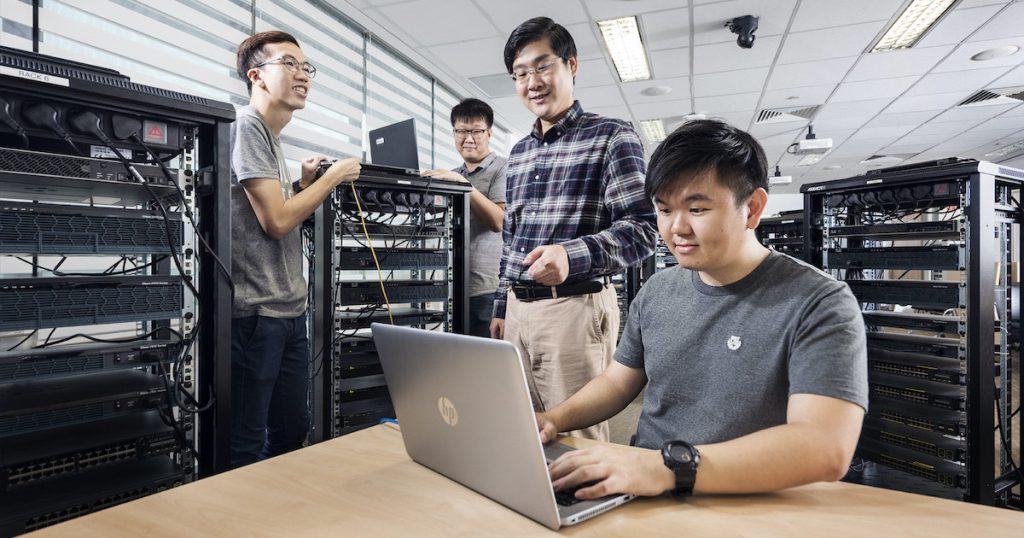
Disclaimer: Opinions presented below belong solely to the author
Parliamentary discussions in Singapore are often a source of valuable information, as questions asked tend to be responded with actual figures, providing an objective view of the situation.
In one of the latest responses to a question asked by Ms He Ting Ru, Workers’ Party MP about the employment situation in the Information & Communications sector in Singapore and how digitalisation of business may influence employment opportunities for local residents, the Ministry of Manpower (MOM) shed a light on the recent trends.
There are 128,900 local residents employed in the sector as of March 2022, but what I think is more noteworthy is the pace of new employment.
Between the fourth quarter of 2021 and the first quarter of 2022, there were 260 retrenchments in the industry as opposed to 6,800 new jobs — or 26 times the number of people that are let go. Moreover, the number of vacancies has also increased, from 8,400 in September 2021 to 10,800 six months later.
That’s over 10,000 jobs in a sector that’s currently employing about 130,000 people, and barely retrenching anyone.
Even if we consider hundreds who are hurt in high-profile layoffs in Shopee, Crypto.com or Coinbase (among many others), they still pale in comparison with the thousands finding new jobs in IT elsewhere.
It should not be all that surprising, considering that while consumer businesses tend to grab the news headlines, IT employment is not confined to the Silicon Valley wannabes.
The oil and gas industry, for example, despite global vilification, is still going strong and keeps adding more IT staff in Singapore — chiefly developers and network administrators — according to GlobalData’s Job Analytics database.


Overall re-employment is the highest since 2015
The situation is good not only in ICT, but the overall market too, as 71.5 per cent of those who lost their jobs managed to find new employment within six months — the highest figure in seven years, according to official MOM data.

Tesla has also bounced back. After making headlines for axing its country head in Singapore just a year after employing him, Tesla is back with several employment offers for specialists in several fields.
The company technically doesn’t qualify as an IT/ICT business (despite all of the innovation it churns out), but what it does show is rationalisation of expenses and prioritisation of employment of specialists over managers.
While I’m not privy to the details, it’s quite certain that the pay package of a country head in a trillion-dollar company had to be substantial — quite likely so much so that they can now employ several people at a cost of one leader (in a market that is still relatively small for the company).
One person’s loss is a gain for seven new hires that Tesla is looking for its offices in Toa Payoh.
Remote work is not for everyone
Meanwhile, as the country ditched almost all pandemic restrictions, the number of vacancies offering remote work in Singapore has dropped by 25 per cent, according to hiring giant Indeed.

This may be an issue to many, particularly young workers in technology companies or tech-related roles, for whom flexibility in the workplace is such a dealbreaker that they make consider switching jobs should their employer not provide the option.
All in all, however, given that the labour market remains favourable to employees in Singapore, it seems that they stand to come out on top as companies hungry for talent adapt their working conditions to land the best people before someone else poaches them.
But the really important takeaway is that digitalisation does not cannibalise jobs, creating more of them instead.
This brings me back to the original questions asked of MOM in the parliament. One of them exhibited a common worry that consolidation and rationalisation of expenses in the IT sector will make some people redundant, ultimately leading to a decrease in employment.
The reality is that there are still an enormous gap in IT talent deployed by companies, including those which never make it to the news headlines.
The current crisis and post-pandemic readjustments forced businesses to invest more in IT solutions, which can make them more resilient in the long-term. This is particularly visible in a country lacking abundance of cheap workforce, like Singapore. Companies can’t just throw more people at a problem — they need solutions that will make them more productive.
It’s just another lesson of the pandemic: overreliance on people creates strategic problems when they can’t go to the office.
At the same time, however, it means that people can do more — even out of office — when they have access to the right tools. And someone has to deploy and maintain them, hence the growing need for IT staff across the entire economy.
After all, the age of completely independent AI is nowhere near and all this technology has to be operated by someone, and that someone will get the job.
Featured Image Credit: Singapore Institute of Technology
Also Read: Not everyone is hiring: Layoffs rock Shopee, S’pore-based Crypto.com as startups bleed jobs
Pads to menstrual patches: This startup delivers period products to your doorstep every month

Since Elaine Hong was 10 years old, she knew that she wanted to dabble in fashion.
She actually realised her dreams — she used to work as a fashion designer, and has worked for various independent brands.
However, her career has since taken a shift. The 29-year-old is now the co-founder and CEO of Enya, a femtech company that’s based in Malaysia.
“I used to experience rashes during my period. The organic [pads] selling in niche stores are expensive [so] I thought it would be a great idea to launch our own,” shared Elaine.
This sparked the idea of Enya, a period care company that specialises in “skin-friendly” period products.
Embracing menstruation
Although every women go through menstruation, this particular topic is very much still seen as ‘taboo’. In fact, it is common among Asian society to view menstruating women as “unclean” and “unhygienic”.
In some cultures, such women are even kept isolated from the rest of their own home by not being allowed to enter the kitchen area or prepare meals.
As a female-centric brand, Enya wants to encourage everyone to embrace menstruation, which is a big part of a woman’s life.

“[We] understand everyone’s menstrual needs and [aim] to be their monthly companion,” said Elaine.
“I go through a lot of discomfort when it comes to menstrual care and one of the main reasons why I decided to jump into this business is because I want all women who go through the same menstrual problems feel like they belong.”
As a company, Enya is focused on providing menstrual products to women to ensure they have quality care during their ‘time of the month’.
There was only one problem that we wanted to solve — period products for people with sensitive skin.
We went on to conduct surveys before our first product launch. Organic cotton is said to be best option — breathable, hypoallergenic, and free of pesticides. It’s suitable for our vaginal skin, which is highly permeable. I’m not a doctor myself, [but] coming from [my own] user experience, this is what I know works for me and we’d like to share this with everybody.
– Elaine Hong, co-founder of Enya

Enya’s first box of organic cotton pads was subsequently launched on International Women’s Day in 2019.
The team also worked towards soft-launching Enya premium earlier this year to test how customers would respond towards organic cotton pads, and that’s pretty much how they started introducing their product into the market.
Get pads delivered to your doorstep every month

Although not a 100 per cent organic brand, Enya’s products are priced slightly higher than the average commercial pads that already exist in the market.
Its average retail prices are from S$5.90 to S$7.90, though users can get it for cheaper through their subscription plans. Subscribers can save five per cent as opposed to a one-time purchase, and opt for deliveries every 15, 30 or 45 days.
They also have the flexibility to skip or cancel their subscription anytime.
The subscription idea came about when a customer suggested to auto-bill her every month so she doesn’t have to reorder them online or purchase in bulk.
– Elaine Hong, co-founder of Enya
After all, as a direct-to-consumer brand, she strongly believes that they need to listen to what customers want.
“We are thankful that our customers are also our ambassadors — we rely on peer-to-peer recommendations a lot,” she added.

Enya has also recently launched a period care kit box to help young girls embrace their menstrual experience from young and educate them on how they can best manage their menstruation.
The period care kit was designed to help women better prepare for their menstrual cycle, and it comes with Enya’s best-selling products: its premium mix box pads, basics pads, Enya plus (good for heavy flow as well as maternity use), pantyliners, and menstrual heating patches.
Business challenges

Sharing more about the early days, Elaine said that fundraising was a struggle because they didn’t have the ‘right’ connections, especially with venture capitalists and retail investors.
This was why they had to bootstrap — she and her co-founders invested all of their savings to start Enya’s first line of production.
She added that they had a very lean team back then. Consisting of only the co-founders and one intern, they had to take on multiple hats, and did most of the business development and marketing themselves.
Brand awareness was another challenge that they faced, so they focused on creating content through social media.
“Our first big break was when a celebrity tweeted about our products,” shared Elaine, without disclosing the celebrity’s identity.
Another business challenge that she faced was people management.
“I think any business owner would tell you that its people are the roots of a company. Especially [so] during COVID-19, we had to move our office to be based home — this includes packing and delivery.”
The pandemic also particularly highlighted to them the importance of online presence. They ramped up their social media efforts, and she noticed that the views on their TikTok videos have been picking up.
Some of our educational videos went viral, and it made an impact when I heard people showing our content with their friends in a cafe. It’s not a huge feat, but it means a lot to us because we wanted to spread inclusive conversations directly revolving around puberty, menstrual and sex education.
– Elaine Hong, co-founder of Enya
This year, she intends to ramp up their focus on customer retention and impactful brand awareness on social media, adding that there are many misconceptions about period that they can explore as content.
“At the end [of the day], our goal is to [make everyone] understand our bodies better — be it our period flow, efficient health check-ups, sexual preferences et cetera.”
It’s now present in four countries across SEA
Since its inception, Enya has expanded across Malaysia, Singapore, Brunei and Myanmar.
“We chose to launch in Singapore first because there were many inquiries from Singaporean customers,” said Elaine.
“If we put this into context of selecting which products are better for our body, we have a lot to catch up to and learn from our neighbouring country. I hope that being in Singapore is able to keep us well-informed, and improve our product performance in the long run.”

To date, it has also worked with over 100 independent pharmacies and 300 selected Watsons stores across the region.
Commenting on the femtech landscape in Singapore, Elaine noted that there are already several players in the space, like Ease Healthcare and Ferne Health.
Instead of seeing them as competitors, she feels that collaboration with such companies is the right step forward, especially between startups and conglomerates.
Startups have the momentum and problem-solving ideas, [while] conglomerates hav the volume and decades of trust from its consumers, so collaboration is key.
– Elaine Hong, co-founder of Enya
Besides partnering with businesses, Enya is also looking forward to working together with experts and schools in the next few months.
Featured Image Credit: Enya
Also Read: This S’pore startup built a “portable powerbank” for EVs – lets drivers charge anytime, anywhere
How these M’sian serial entrepreneurs use NFTs to up the visibility of their other ventures

Co-founders, Azam and Shan, own a whole slew of ventures. First, they started with a vape shop, Panda Vape, and proceeded to open Makan Heritage, Triple A Garage, AOD, Medissa Dental, Vite Arms, and Vite Solutions.
These are a restaurant, motorcycle shop, an auto detailing shop, a chain of dental clinics, a firearms and ammunition agency, and a durian plantation, respectively.
With so many projects under their belt, how then could they maintain and grow their existing customer base while bringing more visibility to their vastly-different businesses?
Being NFT enthusiasts and collectors of these blockchain-backed digital artworks themselves, Azam and Shan turned to NFTs, creating their latest venture, PandaHeritage.
Starting small
PandaHeritage pays homage to two of their businesses, namely Panda Vape, and Makan Heritage.
In 2012, Azam and Shan began their empire by selling their own vape flavour called Captain America, a well-known variety amongst local vapers.
They also provided door-to-door vape cartridge replacement services. “It almost felt like it was an underground thing,” Shan joked.
One after another, they eventually started Makan Heritage in Kota Damansara, a homely restaurant frequented by many locals in that area.

Panda Vape, the previously mentioned vape shop, is located on the second floor of the same building. Vite Arms and a soon-to-be-opened cafe are directly next to it.
Venturing into the NFT space
Prior to starting PandaHeritage on Pentas.io, the brothers were heavy users of OpenSea.io, one of the world’s largest marketplaces for NFTs and crypto collectibles.
They collected multiple artworks on the Ethereum blockchain from plenty of different artists from around the world.
When it came to why they chose the local NFT marketplace over OpenSea for PandaHeritage, they said, “It’s all about the community.”
And it makes sense, seeing how their main following consists of locals, and Pentas.io has become a popular marketplace in the Malaysian NFT scene.
Upon merging the names Panda Vape and Makan Heritage into their NFT project, PandaHeritage, Shan invited his friend from school who is an artist.
They collaborated to create a set of 100 NFTs, all of which are computer-generated variations on the Panda icon.

Upon launching the first 100 units, they were sold out in less than a day. From this, the founders knew their project was well-received, and PandaHeritage has since become another notch in their entrepreneurial belts.
Giving the NFTs a purpose
Today, PandaHeritage NFTs hold value in the utility they offer to Azam and Shan’s customer base.
NFT holders are entitled to a maximum of a 15% discount for each transaction at PandaVape, Makan Heritage, and AOD.
Each artwork acts as a token to redeem the exclusive discounts at a cap of 10 times per month, with no lifetime limit (depending on the tiers).
To make a claim, one would need to scan the QR code. For the regulars at Makan Heritage, the codes will be placed on each dining table.
The verification system for the QR codes is provided by a third-party platform called Imbas.io, a company that aims to simplify the use of NFTs in the real world.
It allows NFT minters to facilitate the implementation of NFTs into their businesses via MetaMask.

We’ve seen how Ad Butcher & Steak, a local steakhouse in Bukit Jelutong, uses a similar third-party tool, Summerwatch Technology, to verify the ownership of the digital art pieces.
The future that it holds
According to the brothers, NFTs in Malaysia are considered to be in their infancy.
They shared that they have always been inspired by the utilities provided by Bored Ape Yacht Club, which uses its NFTs as a token for its exclusive membership club.
It hosts a collection of 10,000 artworks generated from over 172 possible traits, which determine each ape’s rarity.
Each of them has a floor price of 89.99 ETH, equivalent to RM487,331.56 at the time of writing.
Some celebrities who are part of the Bored Ape Yacht Club include Eminem, Serena Williams, Shaquille O’Neal, and Justin Bieber. Others who own Bored Ape NFTs can gain exclusive access to mingle with these celebrities online, and other benefits.

On top of that, the owners are also entitled to free perks that include additional NFTs or tokens from the Bored Ape Yacht Club ApeCoin.
Another perk includes the ability to show off their NFT as their profile picture on Twitter with a Twitter Blue Subscription.
For Azam and Shan, they aim to give more perks as their community grows. They brainstormed some ideas on how they could connect the dots to their other business ventures, such as the durian plantation and a camping reserve that they are currently working on.
“Maybe one day we can take our top 10 NFT holders on a private trip to join us on our camping adventure, all expenses paid,” the brothers remarked. “Or maybe we can take them out on a durian buffet freshly picked from our trees.”
The next stage for PandaHeritage would be to launch a batch of 6,236 NFTs, an amount specifically chosen to equate to the number of verses in the Quran.
In the coming months, the founders also intend to raise the floor price as the number of benefits of each NFT increases.
Also Read: As the first OPPO phone to collab with Hasselblad, is the Find X5 Pro worth the hype?
Featured Image Credit: PandaHeritage
How TIME’s webinar can help local SMEs leverage different online platforms for their brand
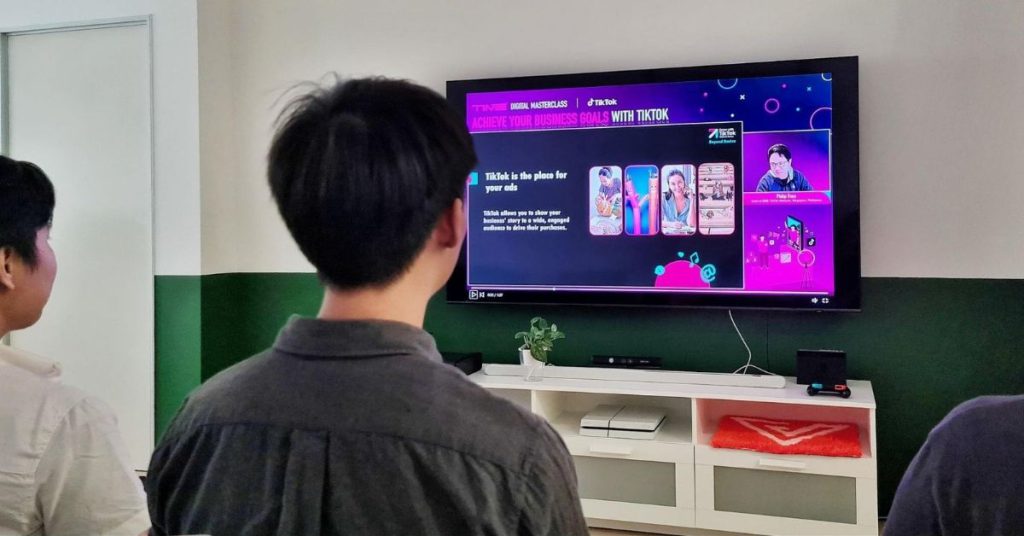
[This is a sponsored article with TIME dotCom.]
Businesses have to adapt their operations by picking up new skills and taking advantage of social media platforms in order to stay competitive in today’s digital economy.
However, some of the major hurdles that are potentially stopping local SMEs from upskilling is that they might not know where to start, which platforms to use, and how to use them effectively.
To help with that, TIME dotCom, an internet service provider, aims to help local SMEs upskill with the TIME Digital Masterclass that’s held every month. So far, they’ve had two sessions.
The masterclasses, which will run until the end of 2022, invite experts from notable companies like TikTok, Shopee, SushiVid, and Kasatria, a Google Analytics Premium Partner to help businesses build their brands on social media.
With the next digital class happening on July 21, 2022, here is what to expect when attending the hour-long session, and the following ones.
Editor’s Note: Registration for the July 21 sessions are now full, according to TIME dotCom. Stay tuned for the upcoming classes in August.
Staying on top of TikTok
The upcoming webinar will be led by TikTok Malaysia’s Business Development Team consisting of Strategic Partnerships Manager, Gwenllian Ching, and Seller & Category Operations Manager, Yuki Peng.
It will talk about utilising TikTok to create engaging, creative content to drive online sales through creator collaborations, campaigns, and promotions.
In addition to that, the speakers will showcase TikTok’s latest feature that’s specifically targeted toward SMEs called TikTok Shop, and how it enables exploration and purchases directly from in-feed videos.
By utilising the knowledge gained from this webinar, SMEs can come up with effective campaign strategies to get more eyes on their brand.
Prior to this, TIME organised a masterclass with Alex Tan, Shopee’s Inbound Sales Team (Corporate Sales) Business Development on how SMEs can make their products stand out from their competitors.

They also talked about the various services that are available on Shopee, how to set a personal or business account, and the differences between the two.
The webinar also touched on product differentiation on Shopee and how to fully take advantage of Shopee’s many campaigns to boost sales.
Based on the feedback of those that participated, 92% of the attendees claimed that the TIME Digital Masterclass was helpful, interactive, and provided valuable insights for running an online SME.
For the following webinars after July’s, TIME has various other topics lined up such as e-commerce platforms, influencer marketing, and how to utilise Google Analytics.
Knowledge is one thing, having the right tools is another
To efficiently run a business online, you’d need to have the right infrastructure.
For example, using an unreliable internet service provider could affect SME’s productivity as they might not be able to connect to cloud services, send over work files, or communicate with other employees online effectively.
This is why TIME provides internet subscription services that cater specifically to businesses.

These include a 100% fibre enterprise-grade network to ensure that there are no service disruptions while running your business due to the fault of the internet service provider.
Furthermore, TIME offers symmetrical download and upload speeds for certain plans, making it suitable for businesses that require high upload speeds.
If you sign up for TIME Fibre Business now, you’ll be eligible for a free Mesh WiFi unit worth up to RM169.
- Find out more information about the TIME Digital Masterclass here.
Also Read: Axdif: An HR management platform that solves communication, planning, & productivity issues
Getting up to speed: SNDGG exec on how S’pore can take advantage of data and AI

Chng Kai Fong, Second Permanent Secretary of the Smart Nation and Digital Government Group (SNDGG) gave the opening address at the STACK-X Data Science Conference in Singapore today (July 7).
The conference is STACK-X Community’s flagship tech and largest government-led conference, with the aim of bringing together like-minded individuals who share a passion for exploring innovative ways of using Tech for Public Good.
STACK-X Community was conceived in 2019 by

During his opening speech, Chng acknowledges that “the power of AI is in its ability to continuously improve with more data exceeding human performance,” citing huge advances in consumer internet and fintech as examples.
[T]his power will soon expand to more domains. As we capture more data, as more data becomes digitised, AI will know us better than we know ourselves. It’s going to change how we work differently. So in government, we all better get up to speed.
– Chng Kai Fong, Second Permanent Secretary of SNDGG
He adds that data science and AI must be taken advantage of by having them integrated into our work such as changing how policies are made, how operations are done, and how services are delivered.
In fact, some agencies have already started doing so, like how National Environment Agency (NEA) works with GovTech in using AI to identify mosquito species, or how the Ministry of Manpower (MOM) uses AI to improve bomb searches.
He went on to further outline three ways in which this use of data and AI in government can be scaled up: getting the data right, building capability and capacity, and working with people both across and outside of the government.
1. Getting the data right
To get the data right, Chng shares that it can be done through government data architecture (GTA) since the quality of the data set comes before AI.
He reminisces about the time in which data was only available months after request, in PDF format. Now with GTA, he highlights that retrieving data only takes seven working days for 99 per cent of data requests within the government.
Furthermore, there are now tools like Vault which enhances the discoverability of data, and analytics.gov to enable public servants to better analyse data.
“But we still have a long way to go and we can still do better. We should be capturing more data. We should be sharing it more real time. We also have to take into account data security [and] data privacy,” he emphasises.
2. Building capability and capacity

Taking in consideration today’s context, Chng highlights how there are playbooks and guides to aid in levelling up at a central level, as well as bootcamps and courses to give agencies a boost.
However, despite embedding data science officers from GovTech in agencies working alongside policymakers, Chng reveals that “not enough of us are using data to make decisions.”
[W]hen I was at EDB (Economic Development Board), we had an extensive data-driven decision making exercise. In fact, we put all data on Tableau — a dashboard — and we try to incorporate it in our decision-making process.
But when I asked the staff for statistics on how often the dashboards are used, the staff sheepishly told me: ‘Oh, only once a year’. So I think we all have a long way to go.
– Chng Kai Fong, Second Permanent Secretary of SNDGG
He stresses that this capability and capacity to fully make use of data frequently has to be an occurrence within the whole organisation, and become a “leadership priority.”
3. Working with people in and out of government
Chng highlights that “the public sector does not have all the answers of expertise”, and that scaling up data science and AI requires working with others.
He suggests that those in the government sector have to work with others better, not just across government, but also with those outside of the government.
“[W]e have to build into our system the culture of working together with others outside,” he says. This means building relations with others and being more confident and open and publishing more data.
I think the right framework is to enable public data to be shared and fused with private datasets, while ensuring that we have security and privacy and actually a proactive approach in working on projects together.
– Chng Kai Fong, Second Permanent Secretary of the Smart Nation and Digital Government Group (SNDGG)
He concludes his opening remarks by linking back to the purpose of the STACK-X conference, which is to facilitate this very behaviour of working together, learning from each others’ expertise, and enabling the exchange between the public and private sector.
“Let us explore possibilities,” he sums up.
Featured Image Credit: Screenshot by Vulcan Post
Also Read: DPM Heng on the future of crypto and fintech in S’pore: public-private cooperation is needed
Here’s a quick guide on how to get a RM50 voucher by subscribing to foodpanda’s pandapro
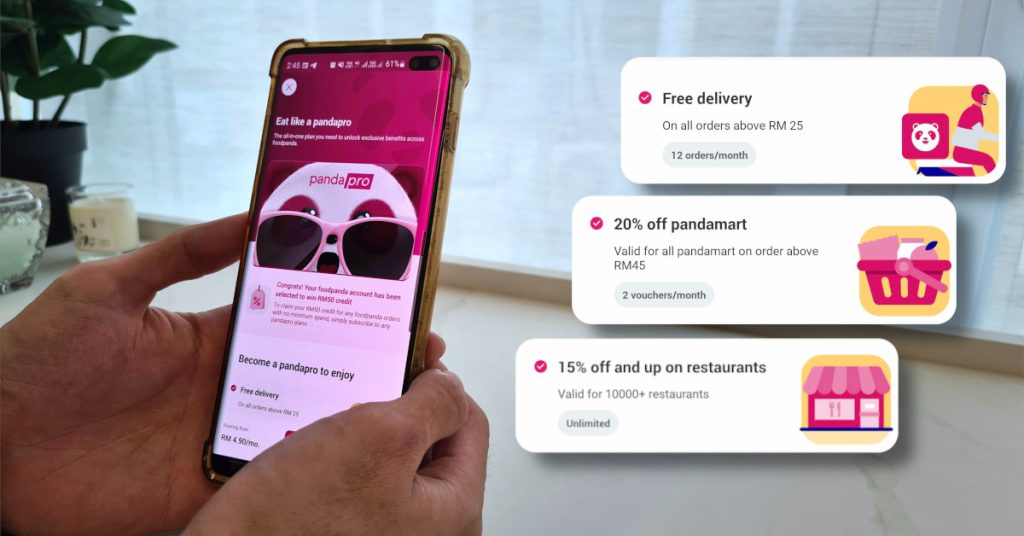
[This is a sponsored article with foodpanda.]
Food delivery services have become synonymous with our daily lives now. They’re no longer just for special occasions, but are also a consideration for your everyday meals, whether at home or at the office.
This means that we are using them more frequently, leading to overall increased spending on our food.
Thus, to benefit their frequent users, foodpanda Malaysia recently announced that they will be giving away a RM50 voucher until the end of July, 2022, to as many as four million Malaysians who sign up for their subscription service, pandapro.
On top of that, they’re awarding new pandapro subscribers two RM8.90 rebates off their subscription, which is equivalent to two months.
That’s not all though—here’s what else you can get out of pandapro, and how to subscribe to it.
Save on each foodpanda transaction
pandapro provides subscribers with several vouchers and benefits every month which include:
- 12x free delivery with a minimum spend of RM25 per order;
- 20% discounts or more on delivery or self-pickup on over 20,000 restaurants;
- 5% additional discounts on self-pickup orders;
- 20% off pandamart purchases over RM45;
- 25% off your total bill when dining in at participating restaurants.

These vouchers and discounts are applicable at all participating restaurants including popular chains like Aroma Village, Kenny Rogers Roasters, and Carl’s Jr that are located in the Klang Valley, East Malaysia, Johor, and more.
In addition to that, you can also get discounts when shopping for daily essentials, household products, and over-the-counter medications via pandamart.
Do keep in mind that some vouchers have certain terms and conditions applied like a minimum spending amount.
The price for the subscription service starts from RM8.90 a month. However, if you sign up for the 6-month subscription plan, you’ll need to pay RM41.40 bi-annually, which is about RM6.90/month.
Let’s say you’re a heavy foodpanda user though, then you might want to subscribe to the yearly plan instead that’s priced at RM58.80 annually, amounting to RM4.90/month.
How do you sign up for pandapro?
Signing up for the subscription plan is quite simple:
- Tap on the menu button at the top left corner of your foodpanda app.
- Tap on “Become a pandapro”.
- Tap on “Select plan”.
- Select your preferred plan.
- Add your preferred payment method and pay the necessary amount.
- Upon successful payment, you will receive the 2 months subscription rebate and RM50 voucher in your “Vouchers” screen within a few days.
- Apply the RM8.90 rebate and get RM50 off on your food and groceries orders right away.
Be sure to check foodpanda’s app daily to find out whether you’re one of the lucky winners to get the 2-month pandapro rebate and RM50 discount voucher.
For a clearer visual on what the step-by-step guide above looks like in the app, check out the pictures below:
Editor’s Update [03/08/22]: foodpanda Malaysia will be celebrating its 10th anniversary this August through an event called panda paradise in Open Carpark Sunway City Kuala Lumpur, where fans can enjoy exclusive live performances by popular artists and take part in lucky draws and contests. panda paradise will only be open to pandapro subscribers. More information to come soon.
Also Read: Axdif: An HR management platform that solves communication, planning, & productivity issues
Hiring hard-headed entrepreneurs could benefit your startup, this M’sian boss shares how
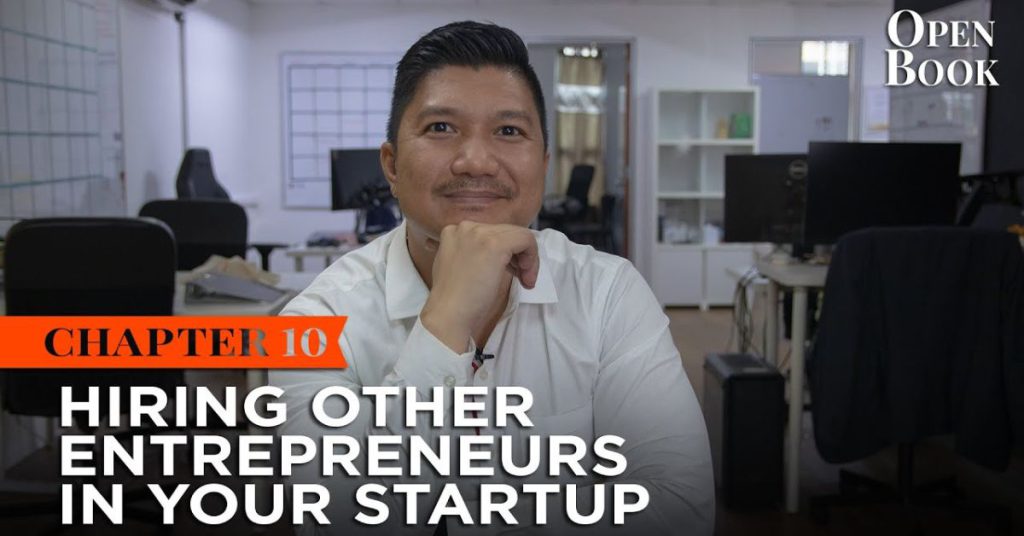
Learning the stories of entrepreneurs in Malaysia for the past few years now, I’ve realised that they share a similar DNA. It’s this mindset of not settling until they find the solution to a problem.
Because founding and running can take up most—if not all—of their time, it’s been said that the only people who can understand them are entrepreneurial peers as well. Hence, the emergence of new friend groups and support systems.
Carliff Rizal takes this one step further, and hires entrepreneurs to work for his own company. He’s the founder of YesHello, a chatbox SaaS for teams that you can learn more about in a full feature we’ve previously written.
About a year into operations, YesHello’s lean team back then comprised seven staff, six of whom were entrepreneurs themselves.
They thrive on momentum
YesHello’s founder noted that the main difference between an entrepreneur and your average employee is in their mindset.
Entrepreneurs are driven by momentum, Carliff stated.
When an entrepreneur finds something exciting, they have a tendency to jump into the problem, working on it until it reaches its 80% to 90% completion rate. Though he sees it as a pro, he acknowledged that it can still be a bit of a con.
“A lot of entrepreneurs tend to not get as excited about that thing anymore [at that rate], then move on,” Carliff said.

“Entrepreneurs feel that when the momentum is gone, we feel like it’s the end of the world. So we will look for other things to do, and projects to be a part of.”
That natural motivation and drive to be doing something is the main element Carliff appreciates about working with entrepreneurs.
But Carliff doesn’t just hire based on whether someone is an entrepreneur or not. He hires based on the presence of an entrepreneurial mindset in a candidate, as that’s most important to him.
They’re stubborn (and that can be a good thing)
Entrepreneurs are somewhat stereotyped as being hard-headed and unable to listen to instructions from management. After all, they are often their own boss in the companies they’ve started.
Sometimes, I even have to pull them back, which is great. I’d rather they go too far and take a risk, then having me say that you’ve gone too far, than having me always push them to do things.
Carliff Rizal, founder of YesHello
As a manager of entrepreneurs, Carliff has to ensure that momentum is kept up in his team. In terms of how that looks like as an actionable, he sets up their goals like a game.
“We have weekly, monthly, quarterly, and annual games that we can win. My job is to have everything be clear for them to play that game, so that they’re always in momentum,” Carliff shared.
In essence, his role is to do is channel his team’s energy to focus on a mutually specific goal to achieve for the company.
They’re constantly on the search to create change
Something that Carliff said during our interview that took us aback was that he felt the biggest benefit of hiring entrepreneurs is that they are weird. But he didn’t mean it in a derogatory way.
“Weird people are the ones who have the goal of changing the world,” Carliff explained. “Even if they don’t know how, they are in the search of how to change the world.”
Encouraging his team to set clear results as goals, Carliff would then send them on their way, allowing them to find their own paths in achieving them.
If they get stuck on something, Carliff ensures his door is always open for them to seek help.
Another beneficial trait about entrepreneurs is that they’re not judgemental. YesHello’s team know how hard it is to run a business, since they’ve tried it themselves and even experienced failure.
“So when they come into another startup, they suggest ways to try things and if it doesn’t work out, it’s fine,” Carliff said.
He added that there’s also less drama and gossip between entrepreneurs who know that meddling in such noise is unproductive to the company’s goals.
“You pick the right people, and that means 99% of your time is spent on achieving goals,” Carliff believes.
Paying entrepreneurs
Since the talents Carliff has gathered to work for his company aren’t fresh grads or new professionals who are still wet behind the ears, you might be wondering, how does YesHello afford to pay its team?
“I’m upfront with them, I truthfully tell them that I can’t pay them much,” Carliff disclosed.
“I’ll pay you let’s say, RM1,800 to RM2,000, maybe. But I’ll make it up by teaching you how I create products, and what is the mindset when we [do certain things].”
The entrepreneurs who work under Carliff will learn about the behind-the-scenes values of running a business that would otherwise take 10 to 15 years of experience to learn.
Understandably, not everyone would agree to such a deal, but those who see the value that Cardiff can give to them beyond monetary incentives are the ones who end up joining him.
Via a mutual agreement, the entrepreneurs he hires aren’t expected to work full time at YesHello. They are still allowed to run their own businesses and do their own things.
Ideas are cheap
With all these entrepreneurs pooled together in Carliff’s startup, we wondered, does he not have the slightest concern that his staff would steal his company’s ideas?
“I’m not too concerned about people stealing [because] ideas are so cheap. Everyone can have ideas. No matter how great the idea, it’s the discipline of implementation that’s the hardest,” argued Carliff.
Even if an idea is present, there are steps that need to be thought out, steps that need implementation which is specific to an intended goal.
To do that requires a lot of discipline, heartache, money, and failure, sacrifices that not everyone is willing to go through. “The pie is big enough, am I worried? Not so much,” Carliff concluded.
-//-
Carliff believes that your ability to build a team is directly related to your ability to be successful in life. He also shared that he wouldn’t be able to build a team he loves working with so much if he had just settled for team members without the entrepreneurial mindset.
This interview was done as part of our ongoing Vulcan Post video series, Open Book, and you can watch Carliff’s video interview here:
Also Read: Almost 7 out of 10 Malaysians are not cleaning their beds properly. This is why you have to.
Upgrading your PC or building a new one? Dynabook’s new SSDs can help give a performance boost
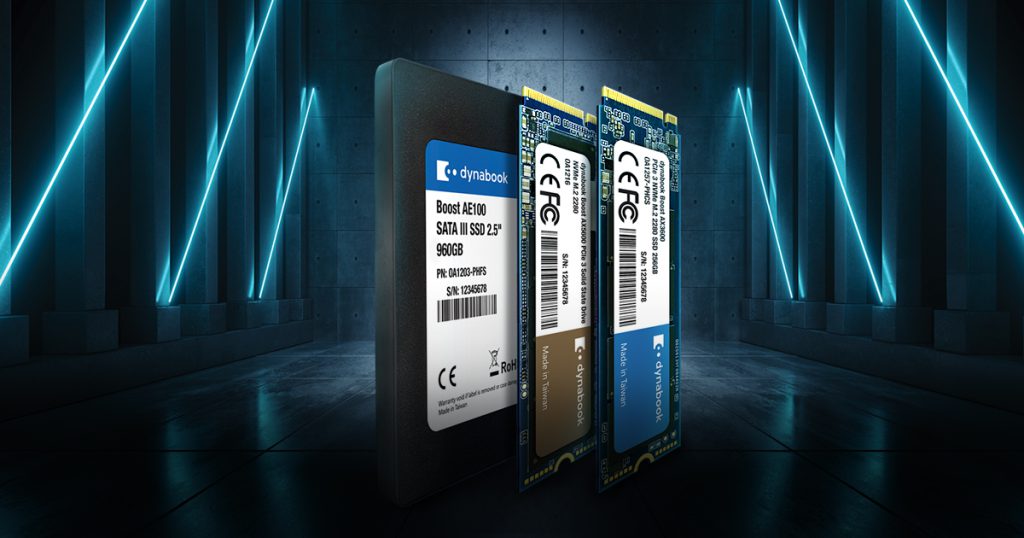
Computers have become a basic necessity in our daily lives. It is a device that we use to access online information, stay connected with people, conduct leisure activities like online shopping, gaming and streaming our favourite shows, and has even become a tool for learning.
Given the overwhelming importance of computers, it should come as no surprise that a good computer is vital to almost everyone.
However, a computer is only as good as its components — and a computer’s hard drive is one of the most important things you should invest in.
When it comes to hard drives, there are two choices: the older hard disk drives (HDDs), and the newer solid state drives (SSDs). SDDs outclass HDDs on many fronts, including being faster, quieter, and more efficient.
Dynabook has been actively promoting their range of SSDs since its launch. Over the years, it has received recognition for its quality and reliability, further enhancing its popularity in the market.
Together with the recent release of a new range with various capacities, Dynabook brings to the table a wider spectrum of SSDs with capabilities fine-tuned to the differing needs of users.
Many in the consumer market may not be all too familiar with the brand name, but Dynabook is indeed a hidden gem with its revolutionary technology capabilities.
The origins of Dynabook
Dynabook is actually not as foreign or new as one might think – it has actually been making waves in the world of computers for decades now.
Toshiba, a well-established household name worldwide, is where you will find the roots of Dynabook.
With the successful integration of its PC business into Sharp Corporation in 2018, Dynabook was introduced to the world to write a new chapter in the company’s continual success stories.
Boasting the technological superiority that Toshiba is known for with over 35 years of laptop heritage, Dynabook has been breaking new grounds, armed with Sharp’s vast market coverage and intimate knowledge of consumer needs.
Having established close global partnerships with major corporate clientele, Dynabook has been able to keep pace with consumer needs by regularly introducing new laptop models that promise improvements in their clients’ security and management solutions.
Building on this, Dynabook has been able to identify other areas whereby their technological strengths and market knowledge can be best applied to assist society’s daily needs.
Dynabook’s current range of SSDs includes the Boost AX5600, the Boost AX3600, and the Boost AE100 – each with different characteristics to serve different audiences.
Meanwhile, the Boost AX7600 – which boasts PCIe Gen4 specifications – is scheduled to be introduced to the market in the near future, after their usual rounds of rigorous in-house and peer testing.
Which SSD should you go for?
Given that each computer will only require one hard drive, we are quite literally spoilt for choice here. Which SSD is the best, and which one should we choose? Well, that depends on our needs.
For those who require the use of advanced softwares such as video editors and graphic designers, the Boost AX5600 might be a good option. This M.2 2280 PCIe Gen 3×4 form factor SSD comes in 512GB, 1TB and 2TB capacities with up to 3300MB/s and 2800MB/s read and write speed respectively.
These high specifications essentially translate into quick access to applications for video editing and graphic design, as well as quick upload and download speeds for users.
Gamers will also find the Boost AX5600’s robust performance translating to a smoother and more enjoyable gameplay. With a five-year warranty, the user will have peace of mind that their hard work is well-protected.
Alternatively, those who favour a longer battery life and need high amounts of storage, such as data analysts, the Boost AX3600 might be a good choice as well.
This M.2 2280 PCIe Gen 3×4 form factor SSD comes in 256GB, 512GB and 1TB, offering a high sequential read speed of 2300MB/s. This ensures that applications are quickly accessible, while upload, and download speeds are kept high, leading to a breeze in content creation works.
Being the best-selling range in Dynabook’s NVMe range of SSDs, the Boost AX3600 is also priced competitively that won’t break your bank, definitely scoring high in the value for money segment. This affordable little powerhouse is further complemented with assurance of a five-year warranty.
Additionally, Dynabook also understands that not everyone uses computers as heavily as graphic designers or data analysts, so they have an SSD for those who use their computers recreationally.
Other than the NVMe segment, Dynabook also offers the Boost AE100. Available in a 2.5” form factor, these drives are lightweight and shock resistant. Capacity ranges from 240GB to 480GB and the new 960GB. It is a definite preferred choice for upgraders as it also comes with a three-year warranty.
The Boost AE100 offers 550MB/s read and write speed, which yields much better performance as compared to the conventional HDD. Suitable for both home and office usage, this is surely a worthy investment – upgrading will allow you to enjoy faster speeds when working on your documents or browsing the web.
This hard drive is also considerably energy efficient, using as little as 2V of electricity, when most SSDs require about 5V.
What’s the catch? Nothing, really
As Dynabook strives for perfection in all their tech and is constantly improving on what works, these already-excellent offerings are nothing special for Dynabook. In their quest to deliver better user experiences for customers, they offer deals that often sound too good to be true.
This latest range of SSDs by Dynabook incorporates the latest Japanese tech with innovations to boot, allowing customers to stay ahead of the times and future-proof their computers.
Some of these improvements include thermal throttling, which can prevent overheating after extended computer use, as well as TRIM, which improves reading and writing performance by automatically removing unused data from the hard disc.
This can come in handy especially since the new hard drives come with a warranty of five years, or when maximum total bytes written has been reached. By removing unused data from the hard disc, the time that is taken to reach the maximum number of total bytes written is delayed, meaning that you can potentially keep using the hard drive for an even longer period of time.
Whether you’re an avid gamer looking to get a new top-of-the-line PC that includes the best SSD on the market, or just using computers casually in your spare time, or anything in between, Dynabook has definitely something for you, with customised offerings to give you what you need, whether its value for money or top-tier performance.
So why wait? Visit Dynabook’s website to check out their range of new SSDs today, and boost your computer to new heights.
This article was written in collaboration with Dynabook.
Featured Image Credit: Dynabook
Also Read: A decade of delivering food and more: How foodpanda is pushing the new era of quick commerce





